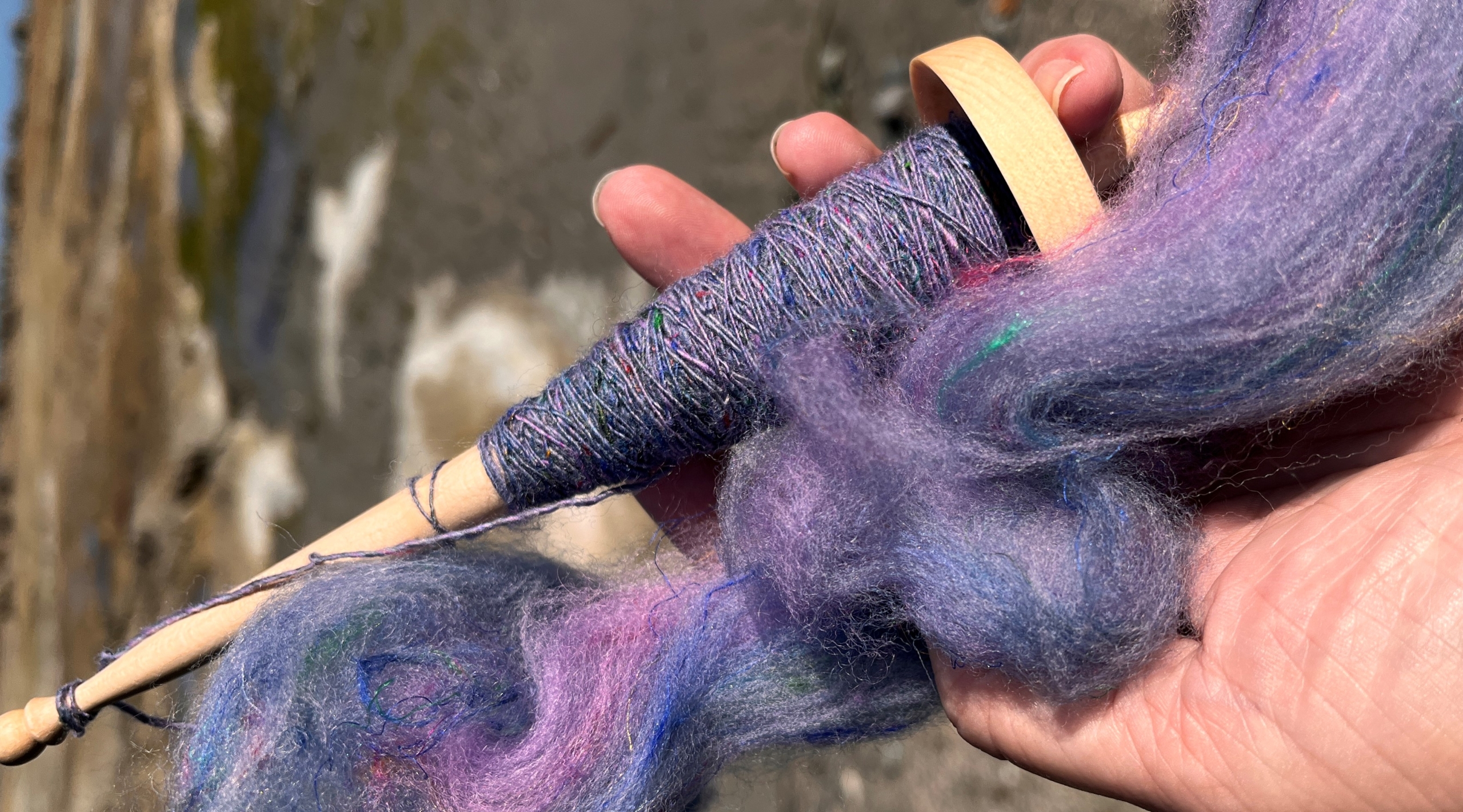Dozens of articles over the past few years have advocated about the benefits of crafting for our mental health, but for a lot of us these stories are not news. I was a very new spinner when a friend first pointed out to me that I was calmer and laughed more when I was spinning, and I know I’m not alone in this. I’ve met spinners who have used the craft to cope with terrible jobs, chronic illness, or family crises. We all find comfort in the flow of fibre through our hands and the gentle rhythm of treadling and drafting. And it turns out it’s all because spinning does good things to our brains.
The relaxation response
If you are a spinner, you already know spinning is relaxing – at least it is once you’ve gotten past that first learning curve and figured out what you’re doing. Spinning engages both the body and the mind to prompt our brains to increase production of “feel-good” hormones called endorphins. In turn, our bodies relax, our heart rate slows, and our blood pressure lowers. As we relax, our brain slows the production of the stress hormone cortisol, a chemical that stimulates inflammation and pain responses. Being relaxed can also lead our brains to tell our gut to release mood-regulating serotonin, which can help us feel happier and less anxious – all because we are using our hands and feet in unison to spin yarn.
The action of spinning is also soothing in and of itself. The gentle repetitive muscle movements of treadling and drafting stimulate our circulatory system, warming our bodies, and increasing the blood flow to our brains. Treadling and drafting puts us in a meditative state as the brain responds to the rhythmic motions.
Rhythm and repetition are also often used as starting points for meditation and mindfulness. Many meditation techniques use rhythmic breathing or the repetition of a word to clear the mind. As our brain focusses on the breath or the word, the thoughts racing through our brain slow and our brain can release more serotonin. (I personally like to think of my habit of counting my treadles as a mantra rather than a chore.)
Rewiring our brains
You may have heard of neuroplasticity – it’s become a bit of a buzzword for selling word games and puzzles. But neuroplasticity is so much more than playing Wordle; it is literally the rewiring of our brain as it faces new concepts or problems. Each time we learn a new technique or spin a new fibre, our brain faces a series of new concepts and problems and builds new neural pathways to send information to other parts of the brain to run the new muscle movements we need to use.
There is so much to learn about spinning besides new techniques. Reading up on shepherding, watching a video about traditional spinning from different cultures, or learning a new way to use the yarn you’ve spun are all ways to keep your brain active. When we learn new things, we use different parts of our brains to process and store the information and we build new neural pathways as we do it.
Spinning also makes us part of a pretty unique group of people. Not everyone does what we do, so when we meet up with fellow spinners to socialize, it feels pretty special. We have a secret language that only we understand, and we can appreciate each other’s accomplishments in ways that most other people can’t. Positive social interactions like spin-ins and online chat groups help rewire our brains for memory and language, and the sense of inclusion boosts our self-esteem.
Pain management
I live with chronic pain from autoimmune arthritis, so this is where I can really appreciate the effects of spinning on our brains. In addition to the endorphin response and neuroplasticity, focusing the stimulation to our nervous system from pain to a pleasurable sensation has been shown to reduce pain signals to our brains.
First proposed by Ronald Melzack and Patrick Wall, the gate control theory of pain management involves two types of nerves carrying signals to our brain: smaller pain-sensing nerve fibres known as C fibres and larger A fibres that carry sensations such as pressure, touch, or temperature. When we stimulate the A fibres, they trigger our spine to produce a chemical that blocks the pains signals being sent by the C fibres, effectively closing the “gate” near the top of our spine to any pain signals trying to reach our brain.
Spinning stimulates those A fibres in a few different ways. First, the repetitive motions of treadling and drafting send the sensation of muscle movement. Then we add the stimulation of the soft feel of the fibres we are drafting, plus the warmth they generate when we hold them in our hands. Doing something we enjoy also triggers endorphin production in our brains, and endorphins work on the same centres in our brain that opioids do, relieving our pain.
A sense of accomplishment
You know that rush of happiness you get when you pull a perfectly balanced skein off the niddy-noddy? When we do something that feels good, our brain releases little doses of a hormone called dopamine. Dopamine is tied to both motivation and accomplishment, and it gives us a euphoric feeling. Whether we have run a marathon, baked a perfect loaf of bread, or spun a hundred yards of yarn, we feel that rush of happiness at our accomplishment.
Beyond that dose of dopamine, spinning our own yarn can foster a sense of independence. Making things builds self-confidence and self-reliance, reminding us that no matter what we are struggling with, we have made this thing. That can lead us to believe that if we can do this, we can do other things, too. We can feel like we are defying capitalism, helping the environment by using natural fibres, or simply filling the need for a warm scarf.
Most of the spinners I know consider spinning a creative outlet. Creativity is so much more than making pretty things – it is problem solving, it is planning, it is improvising when things go wrong, it is celebrating and repeating successes. Creativity is the total engagement of our brains, connecting different areas related to memory, language, spatial reasoning, and emotional responses. Several studies have shown that working with our hands on a repetitive or focused activity helps those connections form. So while we are “mindlessly” spinning, information is travelling around in our brains without the interference of conscious thought. I know I have solved more than one major writing block by spinning and letting my mind wander.
Of course, everyone’s brain is different and many of us face cognitive and mental health challenges that are difficult to explain and even more difficult to overcome. But we can all benefit from the things that happen in our brains when we spin.
Spin on. It’s good for your brain.
 Michelle Boyd is a Master Spinner, weaver, and writer who lives in Old, AB, which is located in Treaty 7 Territory, the ancestral lands of the peoples of the Blackfoot Confederacy. Michelle learned to spin in 1995 when her local yarn shop closed and immediately became obsessed with the art and science of making yarn. She has taught workshops across North America and instructed for the Olds College Master Spinner Program for 15 years. She is also a frequent contributor to both PLY Magazine and Digits & Threads and is currently completing her first book about spinning.
Michelle Boyd is a Master Spinner, weaver, and writer who lives in Old, AB, which is located in Treaty 7 Territory, the ancestral lands of the peoples of the Blackfoot Confederacy. Michelle learned to spin in 1995 when her local yarn shop closed and immediately became obsessed with the art and science of making yarn. She has taught workshops across North America and instructed for the Olds College Master Spinner Program for 15 years. She is also a frequent contributor to both PLY Magazine and Digits & Threads and is currently completing her first book about spinning.





Leave a Reply
Want to join the discussion?Feel free to contribute!